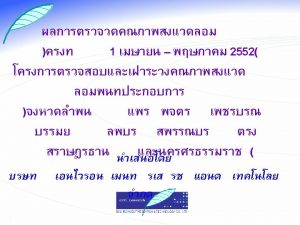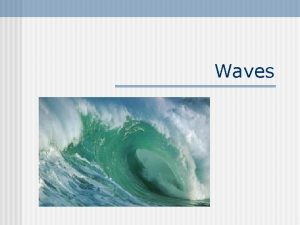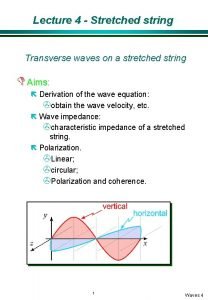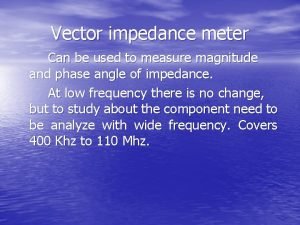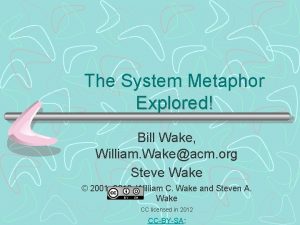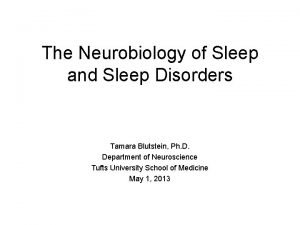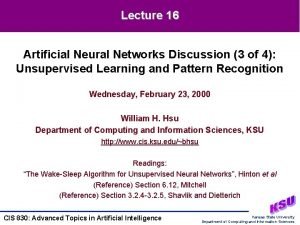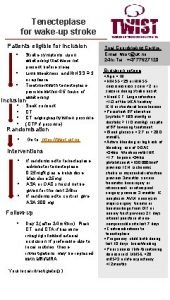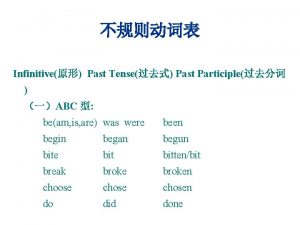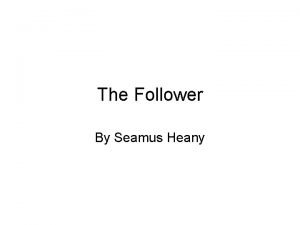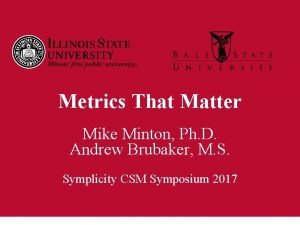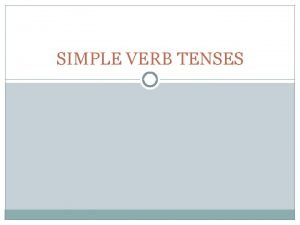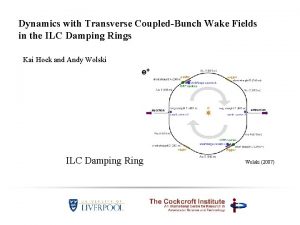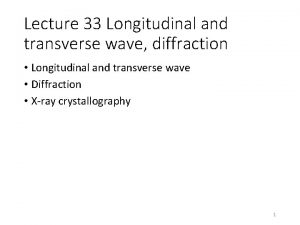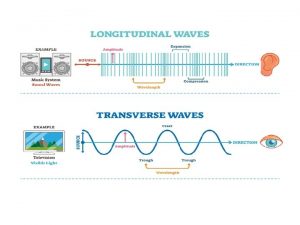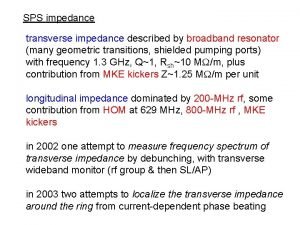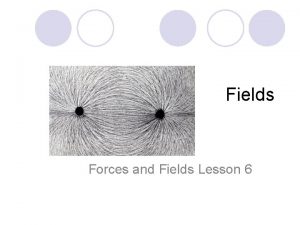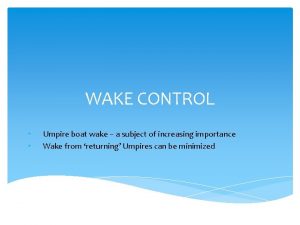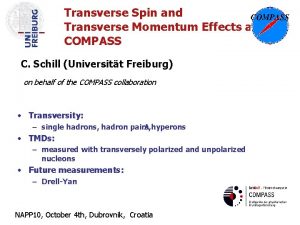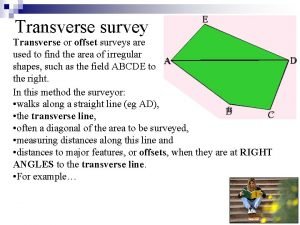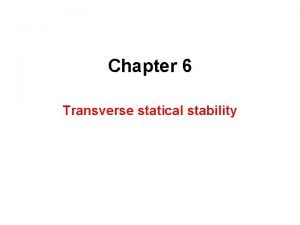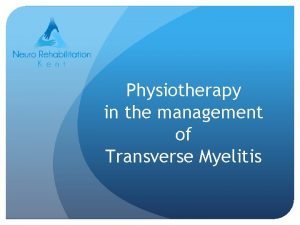Wakefields Impedance wake fields impedance longitudinal impedance transverse































































- Slides: 63

Wakefields & Impedance • wake fields & impedance • longitudinal impedance • transverse impedance 06/25/15 BCM 9

‘test’ particle traveling a distance z behind driving particle experiences longitudinal and transverse wake forces proportional to the product of the two particles’ charges and depend on the distance z , the transverse force is also proportional to the offset of the drive particle from the pipe center, x 06/25/15 BCM 9

transverse wake function longitudinal dipole wake function Panofsky-Wenzel theorem 06/25/15 BCM 9

longitudinal wake function starts at a finite positive value which represents energy loss by the test particle transverse wake function starts at zero and for small |z| grows with a linear slope; negative sign shows that it is defocusing close to the source both wake functions are zero ahead of the source 06/25/15 BCM 9

Fourier transform of the wake function is the impedance usually the real part of the impedance is related to instability growth (or damping) rates; the imaginary part shifts the mode frequencies; energy loss is due to the real part of Z 0|| 06/25/15 BCM 9

longitudinal effects induced voltage parasitic energy loss for Gaussian charge Distribution: 06/25/15 BCM 9

transverse effects deflection (tune shift, focusing change, instability, etc. ) 06/25/15 BCM 9

practical description – effective impedance longitudinal effective impedance transverse effective impedance 06/25/15 BCM 9

practical description – loss factor energy loss per beam particle longitudinal loss factor units: V/p. C transverse kick factor units V/p. C-m sign convention !? 06/25/15 BCM 9

relation between real and imaginary impedance Kramers-Kronig relations due to causality of the wake functions, the impedances cannot have singularities in the upper complex w-plane; then the real and imaginary parts must be related by the above Hilbert transforms 06/25/15 BCM 9

common types of impedance • resistive wall W 0’~1/a, W 1~1/a 3 low frequency impedance coupled-bunch & single bunch • higher-order modes in rf cavities narrow-band resonators drive coupled-bunch instabilities • discontinuities in beam-pipe cross section broadband resonator single bunch 06/25/15 BCM 9

how to measure impedance effects detect variation of observable (tune, orbit, …) with impedance-related parameter like • bunch intensity • bunch length • chromaticity • chamber aperture (e. g. , collimator or insertion device) 06/25/15 BCM 9

parasitic mode energy loss (real part of Z 0) measurements: • coherent synchrotron tune vs. rf voltage for different bunch currents (LEP example) • synchronous phase shift with current • dispersive orbit vs. intensity [local? ] • orbit change with intensity in transport line [local] • threshold of microwave instability (also Im. Z 0) • instabilities during debunching [w dependence!] imaginary part of longitudinal impedance measurements: • bunch lengthening/shortening with current • quadrupole mode frequency (2 Qs) vs. current • shift of incoherent synchrotron tune vs. intensity 06/25/15 BCM 9

LEP model determined with 10 -3 precision voltage calibration from localization of rf cavities (computed) energy loss due to SR and impedance synchrotron tune as a function of total rf voltage in LEP at 60. 6 Ge. V; the two curves are fits to the 640 m. A and 10 m. A data; the difference due to current-dependent parasitic modes is clearly visible (A. -S. Muller) 06/25/15 BCM 9 Qs vs Vrf for Different Beam Intensities

Loss factor - Synchronous Phase Shift with Bunch Current the rf component of the bunch signal filtered from an intensity monitor is compared with rf cavity voltage for different bunch intensities by means of a vector voltmeter SLC Damping Ring 1985 relative phase and amplitude measured while the current is decreased by a scraper early direct measurement at SLAC in 1975 using RF vector voltmeter this gives the energy loss for a given charge; bunch length dependence can be measured as well 06/25/15 BCM 9 M. Allen, et al. , IEEE Trans. On Nucl. Sci. (1975) L. Rivkin, et. al. , IEEE Trans. On Nucl. Sci. (1985) B. Podobedov, R. Siemann, PRST-AB (1998) other possibility: phase distance of 2 bunches with unequal charge (K. Bane in SPEAR)

RF phase measurement using streak camera typically two bunches separated by ~1/2 ring one bunch is weak, used a as a time reference the intensity of the other bunch is varied, and its position w. r. t. weak bunch is measured example measurements from the APS bunch profile bunch centroid shift a loss factor of 10 V/p. C was measured according to simulations, cavities are responsible for 70% of the total measured loss factor 06/25/15 BCM 9 N. Sereno et al. PAC 1997; V. Sajaev, 2014 ICFA impedance workshop

Dispersive Orbit vs. Intensity measure horizontal orbit change with intensity due to energy loss at impedance locations the circumference also changes DC = Dx’ Dx+…!? 06/25/15 BCM 9

localized loss factor: DI – measurement at TRISTAN only total non-cavity related loss factor main complications: orbit noise and BPM intensity dependence measurement result: non-cavity loss factor: ~250 V/p. C RF section loss factor around the ring inferred from dispersive orbit shift 06/25/15 BCM 9 measured loss factor vs. bunch length C. Zhang, Proceedings of EPAC 1996

localized loss factor DI – measurement at LEP by turning off one RF section out of two, loss factor of RF section was measured measurement results: - loss factor of 1 RF section: 210 V/p. C - total loss factor per arc: 90 V/p. C D. Brandt, Proceedings of PAC 199 V. Sajaev, 2014 ICFA impedance workshop 06/25/15 BCM 9

varying local loss factor – measurement at ELETTRA horizontal orbit deviation vs. vertical scraperture g E. Karantzoulis et al. , PRST-AB 6 (2003) orbit deviation looks like dispersion!!? ! 06/25/15 BCM 9

varying local loss factor – measurement at ANKA X orbit change in ANKA when Y collimator is closed example: fitted momentum offset (=energy loss? ) vs. collimator position A. -S. Muller, F. Zimmermann, et al. , EPAC’ 04 06/25/15 BCM 9

localized loss factor Dsz – measurement at the SLC measurement of energy loss due to longitudinal wake fields in the SLC collider arcs, APAC’ 98 note that z. FWHM/2. 355 becomes less than 50 mm near s = 500 m data and fits for other bunch lengths (different settings of bunch compressor voltage and linac RF phase) 06/25/15 BCM 9

longitudinal impedance frequencies – debunching detect unstable frequencies during debunching identify different frequencies with ring components (here effect of MKE kicker magnets) CERN SPS 06/25/15 BCM 9 (E. Shaphoshnikova)

longitudinal impedance – bunch lengthening bunch length changes are defined mostly by a combination of potential well distortion and microwave instability; bunch lengthening due to microwave instability can be described as streak camera is a straightforward way to measure bunch length; measurements at ALS gave Z/n = 0. 2 W J. Byrd, et. al. , Proceedings of PAC 1995 06/25/15 BCM 9

longitudinal impedance – bunch lengthening often bunch lengthening due to potential-wall distortion is important ; simulations (tracking) can deal with complex cases ; calculated wake function was used to simulate bunch lengthening at APS: Y-C. Chae, Proceedings of PAC 2007 06/25/15 BCM 9

SLC Damping Ring 1988 bunch lengthens due to inductive impedance and, at higher current, microwave instability energy spread stays constant up to microwave threshold from where it steeply increases synchronous phase shift was measured as well bunch length was measured by using the RTL bunch compressor as ‘streak camera’ 06/25/15 BCM 9

longitudinal impedance – quadrupole mode shift quadrupole mode frequency shift vs. intensity CERN SPS (E. Shaphoshnikova) 06/25/15 BCM 9

longitudinal impedance – incoherent Qs shift incoherent synchrotron tune can be measured by resonant depolarization on a synchrotron sideband example is from ANKA (A. -S. Muller, EPAC’ 04) frev. Qs change in ratio corresponds to change in bunch length 06/25/15 BCM 9

longitudinal impedance – beam transfer function longitudinal stability diagram 1/BTF(w) of a dense beam obtained with electron cooling (N=7. 7 x 109 protons circulating in LEAR); the harmonic near f=8 MHz was scanned result: Z/n~300± 150 W + i(3500± 1000) W imaginary part dominated by space charge 06/25/15 BCM 9 J. Bosser et al. , 1991

transverse impedance measurements of real part: • head-tail growth or damping rate vs. chromaticity, intensity, bunch length measurements of imaginary part: • betatron tune shift with intensity Im(Z 1) • orbit change with intensity (global or local bumps) [local] • betatron phase advance with intensity [local] • orbit response matrix at different intensities [local] 06/25/15 BCM 9

Head-Tail Growth or Damping Rate measure head-tail growth (or damping) rates for different values of chromaticity, intensity and bunch length growth/damping rate proportional to impedance, chromaticity, intensity and beta function 06/25/15 BCM 9

1/t transverse impedance – head-tail growth rate Q’=14 1/(100 turns) Q’=2. 7 1/t. SR LEP 45. 63 Ge. V, damping rate 1/t vs. Ibunch for different chromaticities [A. -S. Muller] horizontal damping partition number Ib 06/25/15 BCM 9 (A. -S. Muller)

transverse impedance – head-tail growth rate Concurrent measurement of head-tail growth rate measurement SPS measurements in 1999 gave Re(Zeff, y) → Zt= 8. 3± 0. 6 MW/m (assuming resonator impedance at Q~1) Growth rate of the vertical head-tail mode instability (in units of 10− 3 turns− 1), as a function of the decrement of chromaticity. 06/25/15 BCM 9 H. Burkhardt, F. Zimmermann, M. P. Zorzano

Coherent Tune Shift measure coherent vertical tune shift as a function of intensity 06/25/15 BCM 9

transverse impedance – tune shift with current is one of the basic measurements ; it was used to monitor impedance changes in the SPS in preparation for the LHC SPS measurements in 1999 gave Im(Zeff, y) → Zt= 28± 2 MW/m (resonator impedance at Q~1) horizontal and vertical tune as a function of the bunch population horizontal DQ is small and positive due to contribution from “quadrupole wake” for a flat chamber H. Burkhardt, F. Zimmermann, M. P. Zorzano 06/25/15 BCM 9

transverse impedance – tune shift with current at ELETTRA, tune shift was measured after each small-gap chamber installation ; total vertical reactive impedance found: 0. 3 MW/m; impedance of one small-gap chamber: 50 k. W/m for a dipolar wake and “short” bunches, the tune shift is expected to be negative E. Karantzoulis, et. al. , PRST-AB 2003 06/25/15 BCM 9 similar measurements at the SPS by H. Burkhardt et al. , around 2000

example: tune shift vs. scraper-blade position in ELETTRA E. Karantzoulis et al. , PRST-AB 6 (2003) 06/25/15 BCM 9

local measurements using turn-by-turn BPMs if focusing depends on beam current, phase advance depends on current ; local phase advance can be measured by exciting betatron motion and recording on BPMs ; at LEP phase advance was measured as a function of current; from this the impedance of RF cavities and arcs was extracted ; good agreement with expected values was found D. Brandt, Proceedings of PAC 1995 06/25/15 BCM 9

frequency shift of head-tail modes measurements at BESSY Touschek (red) and elastic Coulomb (black) loss rates, and vertical beam size (green) measured as a function of the frequency used for the modulation of the amplitude of the beam exciting 250 MHz voltage. The head-tail modes m=± 1 are excited. 06/25/15 BCM 9 Head-tail modes as a function of current in a single bunch at Q’=0. Note the strong broadening of the m=+1 -mode, the small line emerging from the m=-1 -mode, and the hysteresis effects of this mode between up- and down-scans (green and red curves) at higher beam currents. P. Kuske

Orbit Change –Transverse Wake measure orbit change as a function of intensity and beam position (e. g. , local bumps), or, e. g. , as a function of collimator gap, etc. for large y the dependence becomes nonlinear (Piwinski): 06/25/15 BCM 9

measurement at VEPP-4 M (BINP) to avoid beam current dependence of BPMs, two orbits with low and high beam currents are measured first (without the bump) ; then two orbit with the bump are measured for the same currents ; the resulting orbit change is obtained as difference of differences of orbits: V. Kiselev, V. Smaluk, Proceedings of EPAC 1998 06/25/15 BCM 9

measurement at APS two types of 4 -correctors bumps were tested – parallel and angle bumps ; bump closure is enforced using orbit feedback adjusting 2 correctors; impedance inferred from corrector excitation bump amplitude is scanned as well as the beam current L. Emery, G. Decker, J. Galayda, Proc. PAC 2001 06/25/15 BCM 9

measurement at ESRF a BPM vector is generated as a difference between orbits with +1 mm and -1 mm bumps in the insertion device (ID) of interest; two such measurements are performed for the same total current (22 n. C in 992 bunches or in a single bunch); the difference orbit around the ring is then fitted with 2 correctors located at ends of the ID straight section L. Farvacque, E. Plouviez, Proc. EPAC 2002 06/25/15 BCM 9

example: difference orbit in ANKA with collimator closed and open; red curve is a fit to the optics model which gives the kick A. -S. Muller, F. Zimmermann, et al. , EPAC’ 04 red curve is a fit, scraper is at s=80. 6 m, bx=20. 7, by=8. 0 m, design Dx=0 m, 0. 5 Ge. V, … 06/25/15 BCM 9

example: orbit deflection if either ANKA collimator jaw is closed A. -S. Muller, F. Zimmermann, et al. , 26. August 2003 06/25/15 BCM 9

example: vertical orbit deviation vs. vertical scraperture in ELETTRA E. Karantzoulis et al. , PRST-AB 6 (2003) 06/25/15 BCM 9

example: nonlinear res. -wall & geometric wake deflection; the collimator position is varied for a constant gap size; SLAC linac K. Bane et al. , PAC 95 Dallas 06/25/15 BCM 9 s’y=1. 35 mrad, sz=1. 3 mm, Nb=4 x 1010, E=33 Ge. V, sx, y=80 mm

example: same as previous slide, but deflection plotted vs. distance from lower jaw revealing 1/(a-y 0)2 dependence K. Bane et al. , PAC 95 Dallas 06/25/15 BCM 9

Current Dependent Phase Advance Take 1000 -turn data for different intensity; analysis of the current-dependent phase advance should yield the impedance location and strength effect of a single localized impedance - calculated SPS 06/25/15 BCM 9

impedance acts like current-dependent quadrupole response matrix: 06/25/15 BCM 9

example: localized SPS impedance from current dependent phase advance for impedance localization take data at variable intensity (without changing quadrupoles) some example data: 26 Ge. V/c 06/25/15 BCM 9 14 Ge. V/c

tune shift with intensity, average and spread over all BPMs in the following all data sets with large errors are discarded 06/25/15 BCM 9

typical slope with intensity at a few BPMs from different regions of the SPS at each BPM fit slope and offset to measured phase vs. intensity (above the offset is already subtracted) 06/25/15 BCM 9

result of fitting phase vs. intensity at each BPM offset vs BPM no. slope vs BPM no. 0 -tune at 14 Ge. V/c was quite different from model impedance 06/25/15 BCM 9

fit Df/DN (the 3 rd fit!) by SVD technique with weight and cut-off to the phase beating response matrix; trick to get defocusing impedance: fit in 10 iterations, at each step increase weight of wrong-sign DK by factor 10 06/25/15 BCM 9

the final result: large impedance at 4 -7 locations SPS regions with impedance identified at both energies: 119 (MKP), 301 -307 (arc? ), 417 -422 (MKE), 507 (arc? ) injection kickers 06/25/15 BCM 9 extraction kickers

Impedance from Orbit Response Matrix LOCO orbit response data for different beam intensities ; orbit Response Matrix (ORM) gives precise lattice description ; small lattice changes due to defocusing effect of impedance elements can be captured using ORM fit ; result of an ORM fit is a set of focusing corrections that represent the real lattice - ORM measurements for different currents result in current dependent focusing errors ORM fit should show a current dependent quadrupole at the location of an impedance element example: LOCO measurements at APS V. Sajaev, PAC 2003 Portland (2003) 06/25/15 BCM 9

phase slope from ORM fit minimal quad set that fits the phase slope satisfactory is two quads per sector: one in the middle of ID, and second in the middle of the arc no reason to increase number of quads beyond that – the phase slope curve is too noisy 06/25/15 BCM 9 V. Sajaev, 2014 ICFA impedance workshop

vertical local impedance measurement example impedance distribution was measured before and after installation of two small-gap ID chambers ; average impedance of 8 -mm gap chamber is 20 k. W/m 06/25/15 BCM 9 V. Sajaev, 2014 ICFA impedance workshop

transverse beam transfer function setup for open-loop beam transfer function measurement; θ is the betatron phase advance from kicker to pickup equation for single particle driven by external excitation: beam transfer function (BTF): inverse BTF with Impedance effect: 06/25/15 BCM 9 beam transfer function at low intensity:

transverse impedance from BTF inverting BTF and plotting the imaginary part vs. real part → stability diagram etc. Stability diagram for the n=8 -q betatron sideband. Stability diagram for the n=2 -q betatron sideband. he vertical impedance of the Fermilab Main Ring from BTF measurements. The unit of y axis is in MΩ /m. 06/25/15 BCM 9 P. J. Chou & G. Jackson, 1995

single bunch accumulation limit at the APS and other light sources, the single bunch accumulation limit is an important user parameter; benchmarking the simulated accumulation limit against measurements; for the simulations, the wake potentials are computed and separated into dipolar and quadrupolar components; impedance of the whole ring is represented as a single element per each plane predicted effect of impedance change on accumulation limit Y. -C. Chae, AOP-TN-2009 -008 06/25/15 BCM 9 effective impedance of element depends on beta function at its location; 5 lattices were created with vertical beta function at ID chambers changing from 3 m (nominal) to 5 m

summary • • basics on wake fields and impedance measurements of longitudinal impedance measurements of transverse impedance beam impedance is being measured since more than 50 years; various methods are used; measurement techniques become more sophisticated, while impedances become smaller • BPMs can provide local information • numerical impedance calculations allow for simulation of complex effects
 Red fields
Red fields Transversely framed คือ
Transversely framed คือ Wavelength formula triangle
Wavelength formula triangle Transverse fissure of the brain
Transverse fissure of the brain Transverse frame ship
Transverse frame ship Draw and label transverse wave
Draw and label transverse wave Whats a reflected sound wave
Whats a reflected sound wave Longitudinal transverse vertical
Longitudinal transverse vertical Light is electromagnetic wave true or false
Light is electromagnetic wave true or false Longitudinal vs transverse waves
Longitudinal vs transverse waves Longitudinal and transverse waves
Longitudinal and transverse waves Transverse vs longitudinal waves
Transverse vs longitudinal waves Parietal peritoneum
Parietal peritoneum Transverse impedance of a string
Transverse impedance of a string Vector impedance meter block diagram
Vector impedance meter block diagram Fatigue risk assessment matrix
Fatigue risk assessment matrix Eog grading scale 1-5 nc
Eog grading scale 1-5 nc Wake tech data science
Wake tech data science Bill wake
Bill wake Ivy tech orientation
Ivy tech orientation Andy chan wake forest
Andy chan wake forest Wake tech business analytics
Wake tech business analytics Wake sleep
Wake sleep Keep the soul alive
Keep the soul alive Steve wake
Steve wake Ivy tech advising center
Ivy tech advising center Wake county economic development
Wake county economic development Wake county prepared food tax
Wake county prepared food tax Tagaderms
Tagaderms Sting past simple
Sting past simple Ccp wake tech
Ccp wake tech Woke present tense
Woke present tense Verb 2 meet
Verb 2 meet The wake-sleep algorithm for unsupervised neural networks
The wake-sleep algorithm for unsupervised neural networks Kelvin wake angle
Kelvin wake angle Wake tech library
Wake tech library Get 3 alakja
Get 3 alakja David zhao
David zhao Wake up stroke definition
Wake up stroke definition Family life stage
Family life stage Wake county ems membership
Wake county ems membership Modern standby
Modern standby Wake county beekeepers
Wake county beekeepers Wake county human services community services center
Wake county human services community services center Infinitive past tense past participle
Infinitive past tense past participle Wake county aig identification
Wake county aig identification Special emphasis areas
Special emphasis areas Sharon babcock wake forest
Sharon babcock wake forest Citi training wake forest
Citi training wake forest Full sail strung
Full sail strung Waiting line manament
Waiting line manament Wake forest venice house
Wake forest venice house Your bleeped up brain
Your bleeped up brain Wake forest symplicity
Wake forest symplicity Wake county pta
Wake county pta Sleeping in my orchard a serpent stung me
Sleeping in my orchard a serpent stung me Wake tech baking and pastry arts
Wake tech baking and pastry arts Everyday activities vocabulary
Everyday activities vocabulary Wake past tense
Wake past tense Things fall apart locusts
Things fall apart locusts Wake turbulence avoidance
Wake turbulence avoidance True terror is to wake up
True terror is to wake up Asd college college readiness program
Asd college college readiness program You see jody's new dog yesterday?
You see jody's new dog yesterday?







